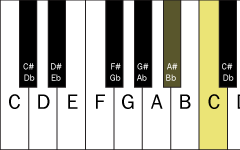Intervals (Part 1): Whole & Half Steps
An interval is the distance between two notes. In this lesson, we will only learn about the half and whole step intervals. Since we haven't learned key signatures yet, we'll relate them to the key of C Major, which has no sharps or flats. The C Major scale starts from C and ends at C.
This is a major scale in the key of C Major. We'll discuss the difference between Major and minor scales, as well as other scales/modes, at a later time. For now we are only considering Major scales.

Imagine a piano. The distance from B to C is a half step because no other notes fall between them. The distance from A to B, however, is a whole step because it consists of two half steps.

Naturally Occuring Half Steps
Each note is a certain distance apart from the next, and they form a pattern that repeats. All Major scales follow this exact pattern: W W H W W W H (whole, whole, half, whole, whole, whole, half). The distance between the first two notes in a Major scale is a whole step. The distance between the 3rd and 4th notes and the 7th and 8th notes are half steps. Those are the two naturally occuring half steps in a major scale.

In a major scale, there are two naturally occuring half steps. In the key of C Major, those two half steps are between B & C and E & F.

Adding Accidentals
Remember from the last lesson that accidentals raise or lower notes by half steps. The interval between E and F is a naturally occuring half step, but if we raised F to F#, we then make the distance further apart. The distance between E and F# is now a whole step because it consists of two half steps (E to F and F to F#).
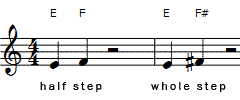
The interval between B and C is also a naturally occuring half step. If we lower the B to B flat, we make the interval larger by increasing the distance between the two notes by half step, which now makes the interval a whole step.
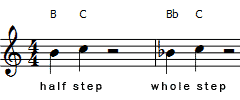
The interval between G and A is a whole step because it consists of two half steps (G to A flat and A flat to A).
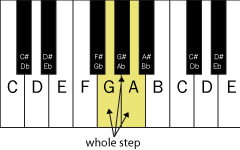
Same Pitch, Different Note Name
Several notes share the same pitch but have different names. For example, A flat is the same pitch as G sharp, and C sharp is the same pitch as D flat. Typically, you would call the half step between C and D a C sharp if there is a C sharp in the key signature or a D flat if there is a D flat in the key signature.
More Examples
Here are a few examples, just to help the concept sink in. Remember that the naturally occuring half steps are between B & C and E & F.
A to B
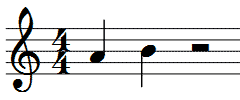
This is a whole step. Why? Because it consists of two half steps. If you look at a keyboard, you can see that there is a note in between these two notes.
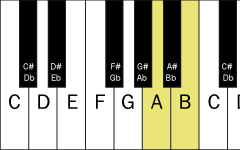
F# to G
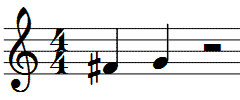
This interval is a half step. Why? The distance from F to G is a whole step, but raising the F to F# makes the interval smaller, which turns it into a half step. Here's how it looks on the keyboard:
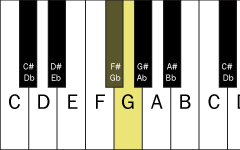
B flat to C
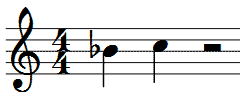
This one is a little tricky. Remember that B to C is a naturally occuring half step, so lowering the B to B flat makes the interval half step larger, which makes this interval a whole step. Here's how it looks on the keyboard:
